Greyia sutherlandii
| Botanical Name | Greyia sutherlandii |
|||||||||||
| Family | Greyiaceae - The wild bottlebrush family. |
|||||||||||
| Pronunciation | GRAY-yuh suth-er-LAN-dee-eye |
|||||||||||
| Common Name(s) |
IsiZulu: isiDwadwa; inDalu; uBande
|
|||||||||||
| Plant Group |
|
|||||||||||
| Plant Size |
|
|||||||||||
| Position |
|
|||||||||||
| General Information |
|
|||||||||||
| Specific Information | When Greyia sutherlandii flowers at the end of winter it makes a startling splash of vibrant colour in a landscape that has not yet lost the drab colours of winter. The huge bottle-brush shaped heads of bright red satiny flowers lure nectar eating birds, bees and other insects. While young trees are compact, older trees spread out with attractive branches and rough bark and are unlikely to reach more than three meters tall in a garden. The leaves are quite large and bright green while young, darkening with age. Reportedly it does not flower well close to the sea, but in my garden, 11 km from the coast, it produces a splendid show. The leaves turn red in late autumn but the specimens in my garden all succumb to severe attacks of rust, turning the leaves black and unattractive during the summer months. Where it is possible to grow this tree in the garden or in a container, it is really worth the while. |
|||||||||||
| Ad Break | ||||||||||||
| Flowers | ||||||||||||
| Description | large, glossy bottle-brush flowers |
|||||||||||
| Season |
|
|||||||||||
| Colour |
|
|||||||||||
| Growth Rate |
|
|||||||||||
| Plant Uses |
|
|||||||||||
| Distribution and Habitat | on slopes and rocky ridges of the Drakensberg, in the Eastern Cape, the eastern Free State, KwaZulu-Natal, Swaziland and eastern Gauteng |
|||||||||||
| Planting Suggestions | Plant in well-drained soil with good aeration. I have found this species prone to rust in our area. This does not prevent spectacular flowering but rather ruins the leaves later in the summer. The old method of digging a deep hole and filling it with soil and compost has resulted in many trees failing to thrive, dying, rotting at the base or worse still, falling over in later years due to poor root development. Refer to the following sites for the best method of planting trees: International Society of Arboriculture: New Tree Planting Tree People: Plant the right way For those of you who have a clay problem try: |
|||||||||||
| Medicinal Uses | Some African tribes use the light, soft wood of the Natal bottlebrush to make household utensils. |
|||||||||||
| Ad Break | ||||||||||||


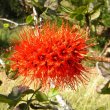
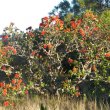
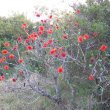
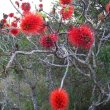
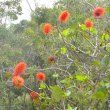
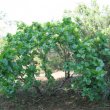
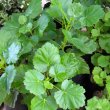


Comments
Age of Greyia sutherlandii before it flowers
Good afternoon ,please could you let me know if Greyia sutherlandii only flowers after a certain age or if i'm doing something wrong .. i have two plants about 2.5 years of age in pots and they are really heathly leaves look good etc ,but they have not even attempted flowering, please advise
Ta and thank you
Lee
Flowering age of Greyia sutherlandia
Hi Lee
I don't think you are doing anything wrong but your expectations may be a bit high. Very few trees will flower as young as this, and although I have no firm statistics, it seems that most trees do not begin to flower before about 4 years - some only flowering after 8 or more years. Unfortunately there is very little information available about the age at which various species begin to flower.
I had a few 4 - 5 year old Greyia sutherlandii in bags but they showed no sign of flowering, possibly because they were bagged. If the plants are healthy and the containers fairly large, your plants should flower in two or three years time.
Regards
Lorraine
Discuss this plant
Share knowledge, ask a question or give an experience.